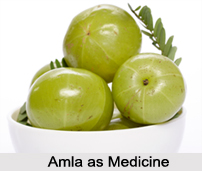 Phyllanthus Emblicaalso is known as emblic myrobalan, Indian gooseberry or Amla. Like chebulic myrobalan, emblic myrobalan is also extensively used in Hindu medicine, both alone and in combination with the two other myrobalans. The fresh fruits are globular, six-striated with a fleshy, acidulous pulp. A preserve of the ripe fruits made with sugar, is considered a wholesome article of diet and a preservative of health. The dried fruits are wrinkled of a blackish grey colour and have an acidulous, astringent taste.
Phyllanthus Emblicaalso is known as emblic myrobalan, Indian gooseberry or Amla. Like chebulic myrobalan, emblic myrobalan is also extensively used in Hindu medicine, both alone and in combination with the two other myrobalans. The fresh fruits are globular, six-striated with a fleshy, acidulous pulp. A preserve of the ripe fruits made with sugar, is considered a wholesome article of diet and a preservative of health. The dried fruits are wrinkled of a blackish grey colour and have an acidulous, astringent taste.
Health Benefits of Amla
The properties of emblic myrobalan are said to resemble those of the chebulic. The fresh juice is cooling, refrigerant, diuretic and laxative. The dried fruits are astringent and useful in haemorrhages. It is said that the exudation from incisions made on the fruits while on the tree, is a very useful external application in recent inflammation of the eye. It is also used as a collyrium, medicated eyewash.
Dose of Amla in Medicine
The following preparation is used as a cooling and stomachic drink in irritability of the stomach. Take emblic myrobalan, raisins, sugar and honey 8 tolas each, water half a seer; rub them together, strain through cloth and administer the strained fluid in suitable doses.
About 2 drachms of emblic myrobalan is recommended to be given in the form of a paste, with the addition of honey for checking menorrhagia and discharge of blood from the uterus. The fresh juice of the ripe fruits is given with honey as a diuretic. A paste of the fruits is applied over the pubic region in irritability of the bladder.
Khandamalaki: Take the pulp of an old gourd of Benincasa cerifera (wax gourd) 400 tolas, clarified butter 2 seers, sugar 400 tolas, fresh emblic myrobalans 4 seers, juice of the gourd of Benincasa cerifera 4 seers; first dry the pulp of the gourd and fry it in the clarified butter. Express the juice of the emblic myrobalans and boil the fried pulp in the mixed juices of the emblic myrobalan and the pumpkin, with the addition of the sugar. When the syrup is thick enough, add the following aromatic substances, namely, long pepper, nigella seeds and ginger, each 16 tolas, black pepper 8 tolas, coriander, cinnamon, tejapatra, cardamoms, flowers of Mesua ferrea (nagakesara), tubers of Cyperus rotundus (mustaka) and the leaves of Pinus Webbiana (talisa), each 2 tolas, all in fine powder and stir with a ladle till intimately mixed. Then add honey one seer and stir well till reduced to the consistence of a confection. This preparation is said to be useful in dyspepsia with pain and vomiting after meals, disinclination for food, pain in the pre-cordial region, etc. It promotes the appetite and acts as a tonic.
Dhatri Lauha: Take powdered emblic myrobalan 64 tolas, prepared iron 32 tolas, liquorice powder 16 tolas, mix them together and soak in the juice of gulancha for 7 times successively. This preparation is given in doses of 20 to 40 grains in anaemia, jaundice and dyspepsia.
Dhatri Arishta: Take the fresh juice of 2000 emblic myrobalans, honey in quantity equal to one-eighth of the juice, powdered long pepper 16 tolas, sugar 6 seers and a quarter; mix them together, boil for a while and leave the mixture to ferment in an earthen jar. This liquor is used in jaundice, dyspepsia, indigestion, cough, etc.
Related Articles
Ayurveda
Origin of Ayurveda
Ayurveda Medication
Elements of Ayurveda
Concepts of Ayurveda
Ancient Literature of Ayurveda
Sushruta Samhita





